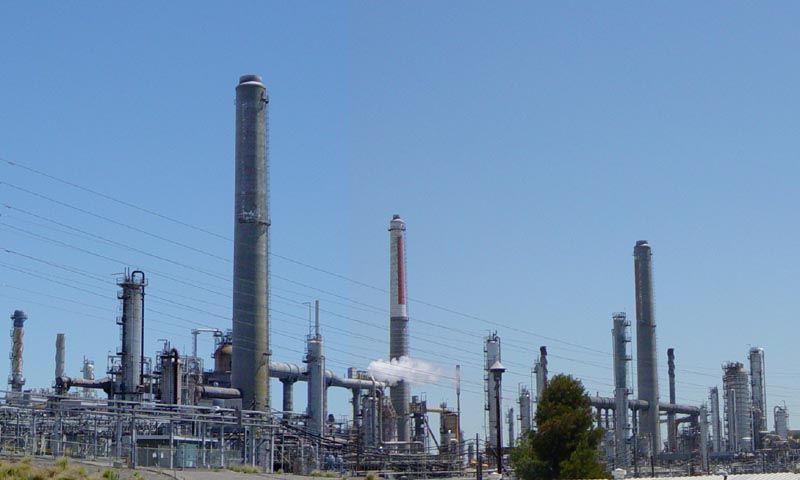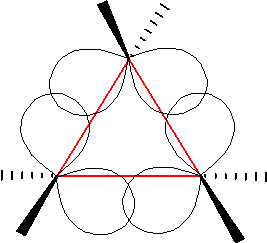|
Methylenecyclopropene
3-Methylenecyclopropene, also called methylenecyclopropene or triafulvene, is a hydrocarbon with chemical formula . It is a colourless gas that polymerizes readily as a liquid or in solution but is stable as a gas.W. E. Billups , Long Jin Lin , Edward W. Casserly "Synthesis of Methylenecyclopropene" J. Am. Chem. Soc., 1984, volume 106, pp 3698–3699. This highly strained and reactive molecule was synthesized and characterized for the first time in 1984, and has been the subject of considerable experimental and theoretical interest. It is an example of a cross-conjugated alkene, being composed of cyclopropene with an exocyclic double bond attached. Description Methylenecyclopropene is the smallest of the fulvenes (a family of unstable, cyclic molecules, conjugated transversally with an odd number of carbon atoms in the ring). The structure of methylenecyclopropene has two interacting double bonds, which represents the simplest transversally conjugated π-bonding system. It is ... [...More Info...] [...Related Items...] OR: [Wikipedia] [Google] [Baidu] |
Fulvenes
Fulvenes are the class of hydrocarbon obtained by formally cross-conjugation, cross-conjugating one Cycloalkane, ring and methylidene through a common exocyclic alkene, double bond. The name is derived from fulvene, which has one pentagonal ring. Other examples include methylenecyclopropene (triafulvene) and heptafulvene. Fulvenes are generally named based on the number of ring atoms. Thus methylenecyclopropene is "triafulvene", methylenecyclopentadiene is "pentafulvene", etc. Preparation Fulvenes are readily prepared by the condensation of cyclopentadiene and aldehydes and ketones: :C5H6 + R2C=O → C4H4C=CR2 + H2O Johannes Thiele (chemist), Johannes Thiele is credited with discovering this reaction. Modern synthesis of fulvenes employ buffer systems. Properties The cross-conjugation generally destabilizes the exocyclic double bond, as (per Hückel's rules) polarization of the π electrons would lead to an aromatic ring ion. Consequently, fulvenes add nucleo- and electr ... [...More Info...] [...Related Items...] OR: [Wikipedia] [Google] [Baidu] |
Heptafulvene
Fulvenes are the class of hydrocarbon obtained by formally cross-conjugating one ring and methylidene through a common exocyclic double bond. The name is derived from fulvene, which has one pentagonal ring. Other examples include methylenecyclopropene (triafulvene) and heptafulvene. Fulvenes are generally named based on the number of ring atoms. Thus methylenecyclopropene is "triafulvene", methylenecyclopentadiene is " pentafulvene", etc. Preparation Fulvenes are readily prepared by the condensation of cyclopentadiene and aldehydes and ketones: :C5H6 + R2C=O → C4H4C=CR2 + H2O Johannes Thiele is credited with discovering this reaction. Modern synthesis of fulvenes employ buffer systems. Properties The cross-conjugation generally destabilizes the exocyclic double bond, as (per Hückel's rules) polarization of the π electrons would lead to an aromatic ring ion. Consequently, fulvenes add nucleo- and electrophiles easily. They also have a small HOMO-LUMO gap, typicall ... [...More Info...] [...Related Items...] OR: [Wikipedia] [Google] [Baidu] |
Hydrocarbon
In organic chemistry, a hydrocarbon is an organic compound consisting entirely of hydrogen and carbon. Hydrocarbons are examples of group 14 hydrides. Hydrocarbons are generally colourless and Hydrophobe, hydrophobic; their odor is usually faint, and may be similar to that of gasoline or Naphtha, lighter fluid. They occur in a diverse range of molecular structures and phases: they can be gases (such as methane and propane), liquids (such as hexane and benzene), low melting solids (such as paraffin wax and naphthalene) or polymers (such as polyethylene and polystyrene). In the fossil fuel industries, ''hydrocarbon'' refers to naturally occurring petroleum, natural gas and coal, or their hydrocarbon derivatives and purified forms. Combustion of hydrocarbons is the main source of the world's energy. Petroleum is the dominant raw-material source for organic commodity chemicals such as solvents and polymers. Most anthropogenic (human-generated) emissions of greenhouse gases are eithe ... [...More Info...] [...Related Items...] OR: [Wikipedia] [Google] [Baidu] |
Methylenecyclopropane
Methylenecyclopropane is an organic compound with the formula . It is a hydrocarbon which, as the name suggests, is derived from the addition of a Methylene group, methylene () substituent to a cyclopropane ring. It is a colourless, easily condensed gas that is used as a reagent in organic synthesis. Synthesis Methylenecyclopropane can be synthesized via an intramolecular cyclisation reaction from methallyl chloride by treatment with a strong base such sodium amide—Sodium tert-butoxide, sodium ''tert''-butoxide (yield 43%) or sodium bis(trimethylsilyl)amide with further treatment by sodium ''tert''-butoxide (yield 72%). Sodium ''tert''-butoxide is used to isomerize byproduct 1-methylcyclopropene into methylenecyclopropane. : Reactions Being a strained and unsaturated molecule methylenecyclopropane undergoes many reactions, especially in the presence of metal catalysts. For example, methylenecyclopropanes can be converted to cyclobutenes in the presence of a platinum catalys ... [...More Info...] [...Related Items...] OR: [Wikipedia] [Google] [Baidu] |
Hydrocarbons
In organic chemistry, a hydrocarbon is an organic compound consisting entirely of hydrogen and carbon. Hydrocarbons are examples of group 14 hydrides. Hydrocarbons are generally colourless and hydrophobic; their odor is usually faint, and may be similar to that of gasoline or lighter fluid. They occur in a diverse range of molecular structures and phases: they can be gases (such as methane and propane), liquids (such as hexane and benzene), low melting solids (such as paraffin wax and naphthalene) or polymers (such as polyethylene and polystyrene). In the fossil fuel industries, ''hydrocarbon'' refers to naturally occurring petroleum, natural gas and coal, or their hydrocarbon derivatives and purified forms. Combustion of hydrocarbons is the main source of the world's energy. Petroleum is the dominant raw-material source for organic commodity chemicals such as solvents and polymers. Most anthropogenic (human-generated) emissions of greenhouse gases are either carbon dioxide ... [...More Info...] [...Related Items...] OR: [Wikipedia] [Google] [Baidu] |
Methylene Group
A methylene group is any part of a molecule that consists of two hydrogen atoms bound to a carbon Carbon () is a chemical element; it has chemical symbol, symbol C and atomic number 6. It is nonmetallic and tetravalence, tetravalent—meaning that its atoms are able to form up to four covalent bonds due to its valence shell exhibiting 4 ... atom, which is connected to the remainder of the molecule by two single bonds. The group may be represented as or , where the '>' denotes the two bonds. This stands in contrast to a situation where the carbon atom is bound to the rest of the molecule by a double bond, which is preferably called a methylidene group, represented . Formerly the methylene name was used for both isomers. The name “ methylene bridge“ can be used for the single-bonded isomer, to emphatically exclude methylidene. The distinction is often important, because the double bond is chemically different from two single bonds. The methylene group should be d ... [...More Info...] [...Related Items...] OR: [Wikipedia] [Google] [Baidu] |
Cyclopropenone
Cyclopropenone is an organic compound with molecular formula consisting of a cyclopropene carbon framework with a ketone functional group. It is a colorless, volatile liquid that boils near room temperature. Neat cyclopropenone polymerizes upon standing at room temperature, and chemical vendors typically supply it as an acetal. The chemical properties of the compound are dominated by the strong polarization of the carbonyl In organic chemistry, a carbonyl group is a functional group with the formula , composed of a carbon atom double bond, double-bonded to an oxygen atom, and it is divalent at the C atom. It is common to several classes of organic compounds (such a ... group, which gives a partial positive charge with aromatic stabilization on the ring and a partial negative charge on oxygen. It is an aromatic compound. See also * Diphenylcyclopropenone * Deltic acid * Tropone References {{Molecules detected in outer space Enones Simple aromatic rings Cyclopropenes No ... [...More Info...] [...Related Items...] OR: [Wikipedia] [Google] [Baidu] |
Fulvene
Fulvene (pentafulvene) is a hydrocarbon with the formula (CH=CH)2C=CH2. It is a prototype of a cross-conjugated hydrocarbon. Fulvene is rarely encountered, but substituted derivatives ( fulvenes) are numerous. They are mainly of interest as ligands and precursors to ligands in organometallic chemistry. Fulvene is an isomer of benzene Benzene is an Organic compound, organic chemical compound with the Chemical formula#Molecular formula, molecular formula C6H6. The benzene molecule is composed of six carbon atoms joined in a planar hexagonal Ring (chemistry), ring with one hyd ..., which when irradiated at 237 to 254 nm forms small amounts of fulvene along with benzvalene. See also * Fulvalene * Methylenecyclopropene References {{Authority control Hydrocarbons Vinylidene compounds Cyclopentadienes ... [...More Info...] [...Related Items...] OR: [Wikipedia] [Google] [Baidu] |
Cyclopropane
Cyclopropane is the cycloalkane with the molecular formula (CH2)3, consisting of three methylene groups (CH2) linked to each other to form a triangular ring. The small size of the ring creates substantial ring strain in the structure. Cyclopropane itself is mainly of theoretical interest but many of its derivatives - cyclopropanes - are of commercial or biological significance. Cyclopropane was used as a clinical inhalational anesthetic from the 1930s through the 1980s. The substance's high flammability poses a risk of fire and explosions in operating rooms due to its tendency to accumulate in confined spaces, as its density is higher than that of air. History Cyclopropane was discovered in 1881 by August Freund, who also proposed the correct structure for the substance in his first paper. Freund treated 1,3-Dibromopropane, 1,3-dibromopropane with sodium, causing an intramolecular Wurtz reaction leading directly to cyclopropane. The yield of the reaction was improved by Gustavson ... [...More Info...] [...Related Items...] OR: [Wikipedia] [Google] [Baidu] |
Cyclopropene
Cyclopropene is an organic compound with the formula . It is the simplest cycloalkene. Because the ring is highly strained, cyclopropene is difficult to prepare and highly reactive. This colorless gas has been the subject for many fundamental studies of bonding and reactivity. It does not occur naturally, but derivatives are known in some fatty acids. Derivatives of cyclopropene are used commercially to control ripening of some fruit. Structure and bonding The molecule has a triangular structure. The reduced length of the double bond compared to a single bond causes the angle opposite the double bond to narrow to about 51° from the 60° angle found in cyclopropane. As with cyclopropane, the carbon–carbon bonding in the ring has increased p character: the alkene carbon atoms use sp2.68 hybridization for the ring. Synthesis of cyclopropene and derivatives Early syntheses The first confirmed synthesis of cyclopropene, carried out by Dem'yanov and Doyarenko, involved the ... [...More Info...] [...Related Items...] OR: [Wikipedia] [Google] [Baidu] |
Polymerization
In polymer chemistry, polymerization (American English), or polymerisation (British English), is a process of reacting monomer molecules together in a chemical reaction to form polymer chains or three-dimensional networks. There are many forms of polymerization and different systems exist to categorize them. In chemical compounds, polymerization can occur via a variety of reaction mechanisms that vary in complexity due to the functional groups present in the reactants and their inherent steric effects. In more straightforward polymerizations, alkenes form polymers through relatively simple radical reactions; in contrast, reactions involving substitution at a carbonyl group require more complex synthesis due to the way in which reactants polymerize. As alkenes can polymerize in somewhat straightforward radical reactions, they form useful compounds such as polyethylene and polyvinyl chloride (PVC), which are produced in high tonnages each year due to their usefulnes ... [...More Info...] [...Related Items...] OR: [Wikipedia] [Google] [Baidu] |
Electron-withdrawing Group
An electron-withdrawing group (EWG) is a Functional group, group or atom that has the ability to draw electron density toward itself and away from other adjacent atoms. This electron density transfer is often achieved by resonance or inductive effects. Electron-withdrawing groups have significant impacts on fundamental chemical processes such as acid-base reactions, redox potentials, and substitution reactions. Consequences of EWGs Effects on Brønsted–Lowry acidity Electron-withdrawing groups exert an "Inductive effect, inductive" or "electron-pulling" effect on covalent bonds. The strength of the electron-withdrawing group is inversely proportional to the Acid dissociation constant, pKa of the carboxylic acid. : The inductive effect is cumulative: trichloroacetic acid is 1000× stronger than chloroacetic acid. : :The impact of the EWG on pKa decreases with distances from the carboxylic group. For benzoic acids, the effect is quantified by the Hammett equation: :\log ... [...More Info...] [...Related Items...] OR: [Wikipedia] [Google] [Baidu] |




